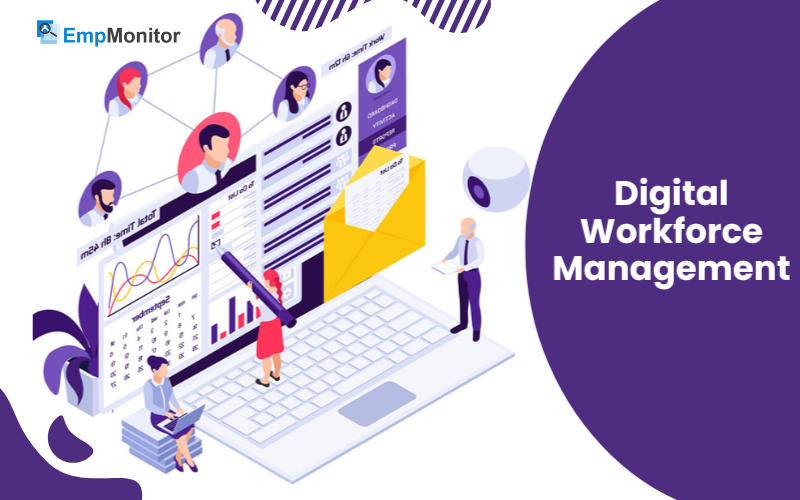In today’s rapidly changing business environment, companies must embrace modern techniques like digital workforce management to manage their workforce effectively. Traditional manual workforce management practices are no longer adequate in the digital age. Although traditional workforce management was once a successful approach, it has various challenges in the contemporary workplace.
One of the primary obstacles is the growing demand for flexible work arrangements. Conventional workforce management techniques may struggle to manage employees who desire remote work or flexible schedules.
Another challenge is the need for a more diverse and inclusive workforce. It’s possible that traditional workforce management methods may not be effective at ensuring that all employees receive fair treatment and have equal opportunities for professional development.
Moreover, the rise of technology has introduced new challenges for traditional workforce management. Many jobs are becoming obsolete due to the growing usage of automation and artificial intelligence. Therefore upgraded skill sets are necessary to remain competitive in the employment market.
Traditional workforce management techniques have significant challenges in the modern workplace, including the need for flexible work arrangements, a more diverse and inclusive workforce, and the impact of technology. As organisations adapt to these challenges, they will be better equipped to succeed in the long term.
Digital workforce management has gained significant traction in recent years, providing organisations with a more efficient and streamlined approach to managing their employees.
You can use workforce management software to manage your workforce with the flexibility to head your employee from anywhere and at any time. This blog will explore the need for digital workforce management, by highlighting its benefits and its impact on modern businesses.
Tap the Play Icon To Listen This Article
Improved Workforce Productivity:
Workforce management systems can automate many laborious and repetitive tasks associated with staff management, including productivity tracking and time-tracking. By automating these processes, organisations can alleviate the administrative burden on their employees and boost overall productivity.
Additionally, digital workforce management solutions offer real-time data tracking and analytics, enabling businesses to make data-driven decisions that enhance workforce productivity.
Are you looking for a powerful workforce management software to manage your employees? Look no further than Empmonitor!
Empmonitor is an excellent workforce management solution that ensures productivity, compliance, and security while improving employee engagement for businesses of all sizes. This single tool has proven to be highly effective in monitoring and tracking the productivity of individual employees.
Empmonitor empowers employers to monitor idle activities and downtime, which leads to increased production. The software is especially beneficial for employers who always have questions about how to manage employees remotely.
Here are just a few of the incredible features Empmonitor offers:
Employee activity monitoring: Gain insight into how your employees utilise websites and other apps to increase productivity.
Time Tracking: Keep track of the amount of time staff spends working.
Performance tracking: Track employee performance based on specific indicators, such as project completion rates.
Productivity monitoring: Ensures your staff meets productivity goals by monitoring their output.
But that’s not all! Empmonitor can also help to boost employee engagement by increasing accountability. Employees are more likely to take responsibility for their work when they know they’re under observation. Monitoring employee behaviour and performance can help identify areas that need improvement.
This software monitors all employees equally, ensuring everyone is to the same standard.
Empmonitor is the perfect tool for any business looking to manage its workforce effectively. Try it today and see the difference it can make.
Smarter Workforce Planning Solution:
Clever workforce planning is essential for any business looking to succeed in today’s fast-paced and competitive market. With the help of a digital workforce management platform, businesses can plan more effectively by having an accurate and up-to-date view of their employees.
These tools enable companies to forecast their future labour requirements, identify areas where they are over or understaffed, and manage their resources more efficiently, improving workforce planning. Businesses can optimise staffing levels, enhance profitability, and improve operational efficiency.
Digital workforce platforms can take business workforce planning to the next level. These platforms give businesses real-time visibility into their workforce, allowing them to make informed decisions. That improves operational efficiency and enhances profitability by minimising cost while ensuring that the right people are in the right place at the right time.
Ultimately, digital employee management platforms enable businesses to stay ahead of the curve and remain competitive in the ever-changing business landscape.
Improved Compliance:
For Companies in heavily regulated industries, managing compliance can be a difficult task. Digital workforce management platforms can aid in ensuring that businesses comply with labour laws, regulations, and policies. These systems can automate compliance monitoring, generate compliance reports, and reduce the risk of compliance violations.
Furthermore, Digital workforce management systems offer various features such as time and attendance tracking, enabling companies to comply with regulations concerning employee hours, overtime, and break times perfectly. These systems also guarantee that workers are adequately trained and certified for their positions, reducing the risk of non-compliance due to insufficient training.
Additionally, these systems can provide audit trails and record-keeping, allowing companies to keep track of their compliance history and demonstrate their adherence to regulation.
Overall, improved compliance through digital workforce management platforms can help businesses avoid expensive penalties and reputation harm while fostering a culture of compliance at the company.
Enhanced Flexibility:
Digital workforce platforms provide flexibility to businesses, enabling them to adapt to changing situations. With the emergence of digital employee management technologies, employers can now manage their personnel from anywhere, at any time. That helps companies with the ability to efficiently handle remote workers, multiple locations, and international teams. All while being able to quickly adapt to changing work conditions.
They also enable businesses to offer their employees flexible working arrangements, such as remote work or flexible hours, which leads to improved job satisfaction and work-life balance. Overall, the flexibility provided by the digital workforce platform allows businesses to be more agile, efficient, and responsive in today’s business environment.
Also Read
10 BEST STRATEGIES FOR MEASURING EMPLOYEE ENGAGEMENT
05 BEST STRATEGIES FOR IMPLEMENTING SUCCESSFUL WORKFORCE PLANNING
Increased Employee Engagement:
The success of a company heavily relies on employees work engagement. To enhance employee engagement, the digital workforce management platform provides self-service options such as accessing schedules, requesting time off, and checking performance data. That, in turn, can result in greater job satisfaction and retention, ultimately leading to the organisation’s success.
This system can provide valuable insights and valuable information on employee performance and productivity. By leveraging real-time data, businesses can make data-driven decisions and identify areas for improvement. Managers can also use these systems to identify skill gaps and training needs, allowing them to provide targeted training programs to employees.
Thus, this technology can help companies foster a tradition of continuous learning and development, resulting in higher employee satisfaction and increased employee engagement.
Cost Effective:
A digital staff management system proves to be a cost-effective solution for businesses. A business can minimise labour expenses and maximise productivity by automating workforce management, decreasing administrative responsibilities, and enhancing productivity. Therefore, implementing a digital employee management system is wise for businesses looking to improve overall efficiency while saving money.
A digital employee management system provides valuable insights and analytics on worker performance and productivity, allowing businesses to make data-driven decisions and identify skill gaps and training requirements, providing employees with customised training programs.
Companies can establish continuous learning and development that improves employee satisfaction and retention by using technology in the workplace to manage personnel. Deploying a digital employee management system is a wise investment for any organisation seeking long-term success, as it is cost-effective and efficient.
Wrapping Words
In conclusion, implementing a digital workforce management system can be revolutionary for companies. It can more effectively manage its workforce and offer greater flexibility to its employees. Overall, the advantages of digital employee management platforms are substantial, and we can expect more organisations to adopt these solutions as technology advances and the job market evolves. Therefore, embracing these technologies can better business outcomes and pave the way for long-term success.


















